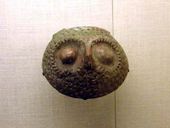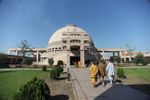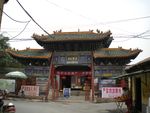هـِنان
| ||||||||||||||||||||||||||||||||||||||||||||||||||||||||||||
| ||||||||||||||||||||||||||||||||||||||||||||||||||||||||||||
خنان (河南؛ وكبديل Honan)، هي مقاطعة حبيسة في جمهورية الصين الشعبية، وتقع في الجزء الأوسط من البلد. وكثيراً ما يشار إليها بإسم ژونگيوان أو ژونگژو (中州)، التي تعني حرفياً "السهل الأوسط" أو "وسط الأرض"، بالرغم من أن الاسم يُستَخدم أيضاً للإشارة إلى كل الصين نفسها. وهي أكبر المقاطعات من حيث تعداد السكان. تتميز بتضاريسها الجبلية في الغرب، والسهول الممتدة في الشرق، حيث يتركز غالبية السكان. هـِنان هي مسقط رأس الحضارة الصينية بتاريخ مسجل لأكثر من 3,000 سنة، وظلت مركز الصين الثقافي والاقتصادي والسياسي حتى نحو 1,000 عام مضت.
مقاطعة هـِنان تضم عدداً كبيراً من مواقع التراث التي تُرِكت في مكانها، ومنها أطلال عاصمة أسرة شانگ ين و معبد شاولين. أربعة من العواصم الثمان القديمة الكبرى للصين، لوويانگ، و آنيانگ، وكايفنگ، و ژنگژو تقع في هـِنان. ممارسة تاي تشي بدأت، أيضاً، في قرية تشن جيا گو (أسلوب تشن)، كما بدأ فيها أيضاً أسلوبا يانگ و وو.[5]
بالرغم من أن اسم المقاطعة (河南) يعني "جنوب النهر [الأصفر]"،[6] تقريباً ربع المقاطعة يقع شمال النهر الأصفر، المعروف أيضاً بإسم هوانگ هى. وبمساحة 167,000 كم²، تغطي هـِنان جزءاً كبيراً من سهل الصين الشمالي الخصب والمكتظ بالسكان. المقاطعات المجاورة لها هي شآنشي، شانشي، خىبـِيْ، شاندونگ، آنهوي و هوبـِيْ. هـنان هي ثالث أكبر مقاطعة في الصين بتعداد يزيد عن 94 مليون نسمة. لو كانت بلداً بنفسها، لكانت هـِنان في الترتيب 14 بين أكبر البلدان تعداداً في العالم، قبل مصر و ڤيتنام.
هـِنان هي خامس أكبر اقتصاد مقاطعة في الصين والأكبر بين المقاطعات غير الساحلية. إلا أن ن.م.إ. للفرد منخفض بالمقارنة مع المقاطعات الشرقية والوسطى الأخرى.
تُعتبر هـِنان واحدة من المناطق الأقل تطوراً في الصين.[7] ويواصل الاقتصاد النمو معتمداً على أسعار الألومنيوم والفحم، وكذلك الزراعة والصناعات الثقيلة والسياحة والبيع بالتجزئة. قطاع صناعات وخدمات التقنية العالية هو أقل تطوراً ويتركز حول ژنگژو و لوويانگ.
التاريخ
تُعتبر هـِنان، على نطاق واسع، مهد الحضارة الصينية مع مقاطعتي شآنشي، شانشي، إذ تُعرف بإزدهارها التاريخي وكبواتها الدورية. الازدهار الاقتصادي نتج من سهولها الخصبة المترامية وموقعها في قلب البلد. إلا أن موقعها الاستراتيجي عنى أيضاً المعاناة من تقريباً كل الحروب الرئيسية في الصين. بالاضافة لذلك، فالفيضانات المتكررة من النهر الأصفر تسببت في خسائر فادحة بين الفينة والأخرى. كايفنگ، بالذات، طمرها غرين النهر الأصفر عدة مرات بسبب الفيضان.
العصر القديم
تكشف المواقع الأثرية أن ثقافات قبل التاريخ مثل ثقافة يانگشاو وثقافة لونگشان كانت ناشطة في ما هو اليوم شمال هـِنان منذ العصر الحجري الحديث. ثقافة إرليتو الأكثر حداثة اقترنت، بشكل مثير للجدل، بأسرة شيا، أول أسرة صينية والأسطورية لحد كبير، التي تأسست تقريباً في القرن 21 ق.م. ويُفترض أن المملكة كلها تواجدت ضمن ما هو اليوم شمال ووسط هـِنان.
انهارت أسرة شيا حوالي القرن 16 ق.م. إثر غزو شانگ، الدولة التابعة المجاورة التي تمركزت حول ما هو اليوم شانگچيو في شرق هـِنان. أسرة شانگ (القرون 16-11 ق.م.) كانت أول أسرة متعلمة في الصين. عواصمها العديدة تواجدت في المدن الحديثة شانگچيو، و يانشي، و ژنگژو. آخر وأهم عواصمهم، ين، الواقعة في آنيانگ المعاصرة، هي حيث خـُلِقت أول كتابة صينية.

في القرن 11 ق.م.، وصلت أسرة ژو من شآنشي في الغرب وأطاحت بأسرة شانگ. وانتقلت العاصمة إلى چانگآن، وانتقل المركز السياسي والاقتصادي بعيداً عن هـِنان لأول مرة. في 722 ق.م.، حين چانگآن دمرتها غزوات الخيون، the capital was moved back east to لوويانگ. This began the فترة الربيع والخريف، a period of warfare and rivalry. What is now Henan and all of China was divided into a variety of small, independent states, constantly at war for control of the central plain. Although regarded formally كحاكم الصين، the control that Zhou king في لوويانگ exerted over the feudal kingdoms had virtually disappeared. بالرغم من الفترة الطويلة من عدم الاستقرار، فقد برز فلاسفة لامعون مثل كونفوشيوس في تلك الفترة وعرضوا أفكارهم في كيفية إدارة الدولة. لاوزي، مؤسس الطاوية، وُلِد في شمال تشو، التي كانت جزءاً من هـِنان الحالية.
Later on, these states were replaced by seven large and powerful states أثناء فترة الدويلات المتناحرة، وانقسمت هـِنان إلى ثلاث دويلات، وِيْ إلى الشمال، و تشو إلى الجنوب، و هان في الوسط. وفي 221 ق.م.، هزمت قوات دويلة چين من شآنشي كل الدويلات الست الأخرى، منهية 800 عام من الاقتتال.
العصر الامبراطوري

العصر الحديث
الجغرافيا
Henan has a diverse landscape with floodplains in the east and mountains in the west. Much of the province forms part the densely populated North China Plain, an area known as the "breadbasket of China". The Taihang Mountains intrude partially into Henan's northwestern borders from Shanxi, forming the eastern edge of Loess Plateau. To the west the Xionger and جبال فونيو form an extensive network of mountain ranges and plateaus, supporting one of the few remaining temperate deciduous forests which once covered all of Henan. The renowned Mount Song and its Shaolin Temple is located in the far east of the region, near the capital city ژنگژو. To the far south, the Dabie Mountains divides Hubei from Henan. حوض نانيانگ, separated from North China Plain by these mountains, is another important agricultural and population center, with culture and history distinct from the rest of Henan and closer to that of Hubei's. Unlike the rest of northern China, desertification is not a problem in Henan, though sandstorms are common in cities near the Yellow River due to the large amount of sand present in the river. At 2413.8 meters above sea level, the highest point in Henan province is Laoyachanao (老鸦岔垴).[8]
The Yellow River passes through central Henan. It enters from the northwest, via the Sanmenxia Reservoir. After it passes Luoyang, the mountains gave way to plains. Excessive amount of sediments are formed due to the silt it picks up from the Loess Plateau, raising the riverbed and causing frequent floods which shaped the habitat of the region. More recently however, construction of dams and levees, as well as the depletion of water resources have ended the floods. The Huai River in southern Henan is another important river, and has been recognized as part of the boundary dividing northern and southern Chinese climate and culture.
Henan shares borders with six other provinces. It is bordered to the west by Shaanxi, to the south by Hubei, and to the north by Shanxi (northwest) and Hebei (northeast). To the east lie Shandong (northeast) and Anhui (southeast), whose borders meet at a narrow strip of land which separates Henan from Jiangsu to the east.
المناخ
Henan has a temperate climate that is humid subtropical (Köppen Cwa or Cfa) to the south of the Yellow River and bordering on humid continental (Köppen Dwa) to the north. It has a distinct seasonal climate characterised by hot, humid summers due to the East Asian monsoon, and generally cool to cold, windy, dry winters that reflect the influence of the vast Siberian anticyclone. Temperatures average around the freezing mark in January and 27 to 28 °C in July. A great majority of the annual rainfall occurs during the summer.
التقسيمات الإدارية
تنقسم هـِنان إلى 17 تقسيم على مستوى محافظة- جميع المدن على مستوى محافظة - واحداهما مدينة على مستوى بلدة.
| الخريطة | # | الاسم | Hanzi | Hanyu Pinyin | النوع |
|---|---|---|---|---|---|

| |||||
| 1 | ژنگژو | 郑州市 | Zhèngzhōu Shì | مدينة على مستوى محافظة | |
| 2 | آنيانگ | 安阳市 | Ānyáng Shì | مدينة على مستوى محافظة | |
| 3 | خبي | 鹤壁市 | Hèbì Shì | مدينة على مستوى محافظة | |
| 4 | Jiaozuo | 焦作市 | Jiāozuò Shì | مدينة على مستوى محافظة | |
| 5 | كايفنگ | 开封市 | Kāifēng Shì | مدينة على مستوى محافظة | |
| 6 | Luohe | 漯河市 | Luòhé Shì | مدينة على مستوى محافظة | |
| 7 | Luoyang | 洛阳市 | Luòyáng Shì | مدينة على مستوى محافظة | |
| 8 | نانيانگ | 南阳市 | Nányáng Shì | مدينة على مستوى محافظة | |
| 9 | Pingdingshan | 平顶山市 | Píngdǐngshān Shì | مدينة على مستوى محافظة | |
| 10 | Puyang | 濮阳市 | Púyáng Shì | مدينة على مستوى محافظة | |
| 11 | Sanmenxia | 三门峡市 | Sānménxiá Shì | مدينة على مستوى محافظة | |
| 12 | Shangqiu | 商丘市 | Shāngqiū Shì | مدينة على مستوى محافظة | |
| 13 | Xinxiang | 新乡市 | Xīnxiāng Shì | مدينة على مستوى محافظة | |
| 14 | Xinyang | 信阳市 | Xìnyáng Shì | مدينة على مستوى محافظة | |
| 15 | Xuchang | 许昌市 | Xǔchāng Shì | مدينة على مستوى محافظة | |
| 16 | Zhoukou | 周口市 | Zhōukǒu Shì | مدينة على مستوى محافظة | |
| 17 | Zhumadian | 驻马店市 | Zhùmǎdiàn Shì | مدينة على مستوى محافظة |
الديمغرافيا
| Year | Pop. | ±% |
|---|---|---|
| 1912[9] | 28٬518٬000 | — |
| 1928[10] | 30٬566٬000 | +7.2% |
| 1936–37[11] | 34٬290٬000 | +12.2% |
| 1947[12] | 29٬654٬000 | −13.5% |
| 1954[13] | 44٬214٬594 | +49.1% |
| 1964[14] | 50٬325٬511 | +13.8% |
| 1982[15] | 74٬422٬739 | +47.9% |
| 1990[16] | 85٬509٬535 | +14.9% |
| 2000[17] | 91٬236٬854 | +6.7% |
| 2010[18] | 94٬023٬567 | +3.1% |
With a population of approximately 93.6 million, Henan is the third most populous Chinese province after Guangdong and Shandong. It is also the fifth most populous sub-national division in the world. If it were a country by itself, it would be the twelfth most populous in the world, just behind Mexico and ahead of the Philippines. However, the hukou system shows Henan as the most populous province in China with over 103 million people, as it counts the migrant Henanese laborers as residents of Henan, instead of the province they currently reside in. On the other hand, Guangdong is shown as having only 81 million people, though the actual population is 95 million due to the influx of migrants from other provinces.
The population is highly homogeneous with 98.8% of the population being Han. Small populations of Mongols and Manchus exists in scattered rural communities as well as major urban centers. Along with Jiangxi, Henan has one of the most unbalanced gender ratios in China. As a result of the Chinese government's one-child policy (many parents do not want the only child to be female and abort the fetus), the gender ratio was 118.46 males for 100 females in 2000. Subsequently, aborting fetuses due to their female sex was banned in Henan and heavy fines are issued for those who violate the law. In addition, daughter-only families receive an annual allowance from the government.[19] Despite these efforts the problem seems to have become far worse. Based on a 2009 British Medical Journal study, the ratio is over 140 boys for every 100 girls in the 1–4 age group;[20] this might be a strong exaggeration, as many families with more than one child do not register their daughters to the hukou in order to escape fines.
الدين
الدين في هـِنان (2012)[21]
According to a 2012 survey[21] only around 13% of the population of Henan belongs to organised religions, the largest groups being Buddhists with 6.4%, followed by Protestants with 5.6%, Muslims with 1.3% and Catholics with 0.5%. Henan has some important centres of Chinese Buddhism, the White Horse Temple and the famous Shaolin Monastery.
السياسة
الاقتصاد
الزراعة
يجتاز نهر هوانگ هي المنطقة الشمالية، وتكثر الهضاب الخصبة في المناطق الوسطى من المقاطعة. المحصول الرئيسي هو الأرز، إلى جانب القطن، التبغ، الفول السوداني والسمسم (تستعمل في صناعة الزيوت الغذائية).
الموارد
يعتبر الفحم من أكثر الموارد الطبيعة المستغلة. تم تحويل مجرى نهر هوانگ هي، بهدف التحكم في عمكلية سقي الأراضي الزراعة، وتم في نفس الوقت الإستفادة من الطاقة الكهرومائية (كهروهيدروليكية) للنهر.
الصناعة
تنتشر في أرجاء المقاطعة مصانع لنسيج، آلات التصنيع، كما تحول مصانع أخرى الحديد وتنتج الألمنيوم. استفاد الاقتصاد المحلي من مشروع تحويل النهر، وخطة التصنيع التي قامت بها الحكومة بين سنوات 1950-1960 م. سنة 1975م تهدم اثنان من السدود الموجودة في المنطقة وتسبب الحادث في مصرع أزيد من 230,000 شخص، توفي أغلبهم بسبب الفيضانات وقضت على الآخرين الأوبئة والمجاعة التي أعقبت الحدث.
الثقافة
الكليات والجامعات
المصادر والهوامش
- ^ "Doing Business in China – Survey". Ministry of Commerce – People's Republic of China. Archived from the original on 5 August 2013. Retrieved 5 August 2013.
- ^ 百度百科-河南. National Bureau of Statistics of China.
- ^ 河南省2017年国民经济和社会发展统计公报 [Statistical Communiqué of Henan on the 2017 National Economic and Social Development] (in الصينية). Statistical Bureau of Henan. 2018-02-27. Retrieved 2018-06-22.
- ^ 《2013中国人类发展报告》 (PDF) (in الصينية). United Nations Development Programme China. 2013.
- ^ http://www.china-taichi-guide.com/Taichi-Locations/Chenjiagou.php
- ^ (صينية) أصول أسماء مقاطعات الصين، People's Daily Online.
- ^ "China dreams on hold: heartland city feels chill of economic slowdown". Reuters (in الإنجليزية). 2019-05-28. Retrieved 2019-06-13.
- ^ http://dy.163.com/v2/article/detail/CTSRLRBH0524E1T0.html
- ^ 1912年中国人口. Retrieved 6 March 2014.
- ^ 1928年中国人口. Retrieved 6 March 2014.
- ^ 1936–37年中国人口. Retrieved 6 March 2014.
- ^ 1947年全国人口. Retrieved 6 March 2014.
- ^ 中华人民共和国国家统计局关于第一次全国人口调查登记结果的公报. National Bureau of Statistics of China. Archived from the original on 5 August 2009.
{{cite web}}: Unknown parameter|deadurl=ignored (|url-status=suggested) (help) - ^ 第二次全国人口普查结果的几项主要统计数字. National Bureau of Statistics of China. Archived from the original on 14 September 2012.
{{cite web}}: Unknown parameter|deadurl=ignored (|url-status=suggested) (help) - ^ 中华人民共和国国家统计局关于一九八二年人口普查主要数字的公报. National Bureau of Statistics of China. Archived from the original on 10 May 2012.
{{cite web}}: Unknown parameter|deadurl=ignored (|url-status=suggested) (help) - ^ 中华人民共和国国家统计局关于一九九〇年人口普查主要数据的公报. National Bureau of Statistics of China. Archived from the original on 19 June 2012.
{{cite web}}: Unknown parameter|deadurl=ignored (|url-status=suggested) (help) - ^ 现将2000年第五次全国人口普查快速汇总的人口地区分布数据公布如下. National Bureau of Statistics of China. Archived from the original on 29 August 2012.
{{cite web}}: Unknown parameter|deadurl=ignored (|url-status=suggested) (help) - ^ "Communiqué of the National Bureau of Statistics of People's Republic of China on Major Figures of the 2010 Population Census". National Bureau of Statistics of China. Archived from the original on 27 July 2013.
{{cite web}}: Unknown parameter|deadurl=ignored (|url-status=suggested) (help) - ^ english@peopledaily.com.cn. "People's Daily Online – China's most populous province legislates to curb gender imbalance". peopledaily.com.cn.
- ^ Zhu, Wei Xing; Lu, Li; Hesketh, Therese (9 April 2009). "China's excess males, sex selective abortion, and one child policy: analysis of data from 2005 national intercensus survey". BMJ. 338: b1211. doi:10.1136/bmj.b1211. PMC 2667570. PMID 19359290 – via www.bmj.com.
- ^ أ ب China Family Panel Studies 2012: 当代中国宗教状况报告——基于CFPS(2012)调查数据 (PDF). 2014-03-03. p. 13. Archived 9 أغسطس 2014 at the Wayback Machine
وصلات خارجية
- Pages using gadget WikiMiniAtlas
- CS1 uses الصينية-language script (zh)
- CS1 الصينية-language sources (zh)
- CS1 uses اليابانية-language script (ja)
- CS1 errors: unsupported parameter
- Articles with hatnote templates targeting a nonexistent page
- Short description is different from Wikidata
- Articles containing صينية-language text
- Coordinates on Wikidata
- Pages using infobox settlement with missing country
- Articles containing Chinese-language text
- Articles containing simplified Chinese-language text
- هـِنان
- وسط الصين
- مقاطعات الصين










